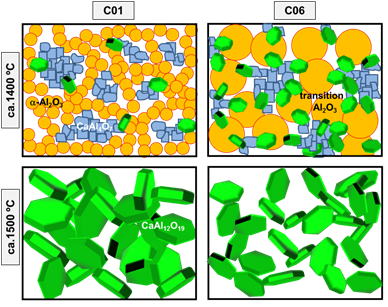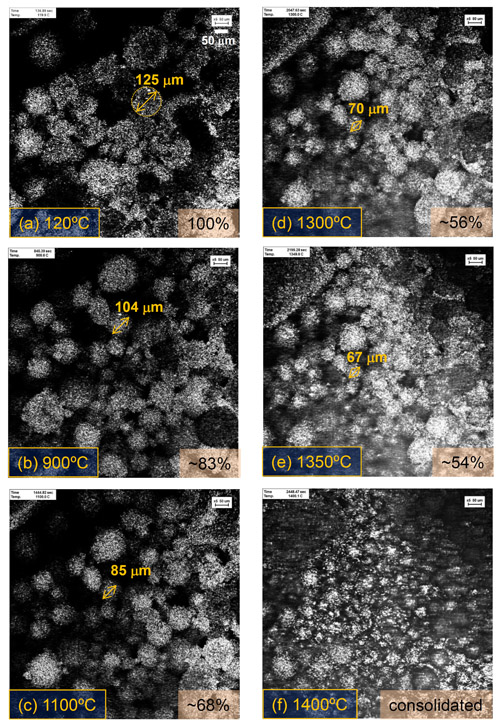Homogeneously bulk porous calcium hexaaluminate (CaAl12O19): Reactive sintering and microstructure development
Porous CaAl12O19 ceramics attract much attention toward many potential applications, such
as high-temperature filters, catalyst supports, and lightweight structural
materials at high temperatures. In this study, we have focused on the reactive
sintering and microstructure development of homogeneously bulk porous CaAl12O19. Boehmite AlOOH powders with different particle size [0.08 micrometer
(C01) and 0.7 micrometer (C06)] were used as Al2O3 sources. CaCO3 and boehmite powders were wet-ball milled, and the green compacts were
sintered in air at 520 degC, 750 degC, 1100 degC, 1200 degC, 1300 degC,
1400 degC, 1500 degC (3 h) and 1600 degC (3 h), in order to analyze the
microstructure development. At 1500 degC (3 h), microstructure became macroscopically
homogeneous. The porosities of the C01 and C06 samples sintered at 1500
degC were calculated to be 51% and 56%, respectively. Stacking of the plate-like
grains and their card-house structures are observed. Such card-house structures
stabilize the open-porous structure even at 1600 degC. Just by changing
the size of starting boehmite AlOOH powders, the size of the CaAl12O19 plate-like particles was altered with keeping similar porosity.
均質なバルク多孔質ヘキサアルミン酸カルシウム(CaAl12O19):反応焼結および微構造形成
多孔質CaAl12O19セラミックスは、高温フィルター、触媒担体、および高温での軽量構造材料など、多くの潜在的用途に大きな注目を集めている。本研究では、均質なバルク多孔質CaAl12O19の反応焼結および微構造形成に焦点を当てている。 Al2O3源としては、粒径の異なるベーマイトAlOOH粉末[0.08マイクロメータ(C01)および0.7マイクロメータ(C06)]を使用した。 微構造の形成過程を解析するために、750℃、1100℃、1200℃、1300℃、1400℃、1500℃(3時間)および1600℃(3時間)にて大気中で焼結した。微構造は1500℃(3時間)の焼結で巨視的に見て均一になった。
1500℃で焼結されたC01およびC06試料の気孔率は、それぞれ51%および56%と計算された。積み重なった板状粒子とそのカードハウス構造が観察されている。このようなカードハウス構造は、1600℃であっても開気孔構造を安定化させる。ベーマイトAlOOH粉末のサイズを変えるだけで、CaAl12O19板状粒子のサイズは、同様の多孔性を維持しながら変化した。
|
 |
K. Kawaguchi, Y. Suzuki, T. Goto, S. H. Cho, T. Sekino, Ceram. Int., 44
[4] 4462-4466 (2018).
https://doi.org/10.1016/j.ceramint.2017.11.138 |
|
Spherical porous granules in MgO-Fe2O3-Nb2O5 system: In situ observation of formation behavior using high-temperature
confocal laser-scanning microscopy
The pyrolytic reactive granulation process, yielding ceramic spherical porous granules, is simple, consisting of typical ceramic processing methods, viz., wet-ball milling of powders, vacuum drying, granulation via sieving through a screen mesh, and one-step heat treatment for local reactive sintering within each granule.
Here, the microstructural development of spherical porous granules was
successfully visualized by in situ high-temperature confocal laser-scanning
microscopy during the heating up to 1400 degC in air. Based on the result
of the in situ observation, a simple but powerful size-controlling process
of spherical porous granules, viz., multiscreen sieving after the heating
was demonstrated. Nearly monodispersed spherical porous granules composed
of pseudobrookite-type MgFeNbO5 were easily obtained.
MgO-Fe2O3-Nb2O5系多孔質球状顆粒:高温共焦点レーザー走査型顕微鏡を用いた生成挙動のその場観察
熱分解反応造粒プロセスは、セラミックス多孔質球状顆粒を得る手法であり、単純かつ典型的なセラミックスプロセスである。粉末の湿式ボールミル粉砕、真空乾燥、スクリーンメッシュを用いた分級による造粒、および各顆粒内の局所反応焼結のための1ステップの熱処理から構成されている。
本研究では、大気中1400℃まで加熱する際の、多孔質球状顆粒の微構造形成過程を、その場高温共焦点レーザー走査型顕微鏡観察によって可視化することに成功した。その場観察の結果に基づき、球状多孔質顆粒のサイズ制御には、加熱後のマルチスクリーン分級が単純ではあるものの非常に有効であることが実証され、
擬ブルッカイト型MgFeNbO5からなるほぼ単分散の多孔質球状顆粒が容易に得られることが示された。
|
 |
Y. Suzuki, H. Abe, H. Yamamoto, K. Ito, H. Inoue, M. Nakamura, J. Eur. Ceram. Soc., 37 [16] 5339-5345 (2017).
http://dx.doi.org/10.1016/j.jeurceramsoc.2017.05.056 |
|
|
|
Copyright (c) 2011-2018 Yoshikazu Suzuki Laboratory, University of Tsukuba
|
|

